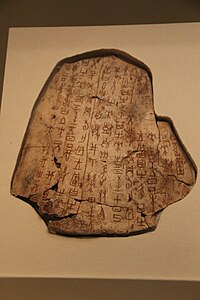| Religion of the Shang dynasty | |
|---|---|
 A Shang oracle bone inscribed with the results of divination.[1] | |
| Type | Polytheistic religion |
| Theology | |
| Region | Yellow River valley |
| Language | Old Chinese |
| Part of a series on |
| Chinese folk religion |
|---|
 |
The state religion of the Shang dynasty (c. 1600 – c. 1046 BC) involved trained practitioners communicating with deified beings, including deceased ancestors and supernatural gods. Methods of communication with the spirits consist of inscribed divinations on oracle bones and sacrifice of living beings. The Shang dynasty also had large-scale constructions of tombs,[2] which reflects their belief in the afterlife, along with sacred places. Numerous Shang vessels, as well as oracle bones, have been excavated in the kingdom's capital Yin.[3][4] These archaeological discoveries facilitate understandings of Shang religious beliefs and practices through a large amount of evidence.[5] Headed by the exalted Dì, the deities formed a pantheon.[6]
The Shang kingdom's religion, which played an important role to royal adherents, accounted for a significant portion of court life. Their deities consistently received various honorary ceremonies. For this, Shang astronomers created a sophisticated calendrical system based on a sixty-day revolution.[7] Complying with the calendar, royal adherents of the religion conducted liturgical rituals dedicated to those spirits. Regional estates maintained independent practitioners but worshipped the same deities for common purposes. Those acts of worship, which were formalized over time, were held for divine fortune along with prosperity of the late Shang state.[8]
The Shang religion originated in the Yellow River valley, heartland of the Chinese civilization from around 1600 to 1046 BC.[a] The earliest inscriptions date back to roughly one millennium before the end of ancient China, or c. 1250 BC, during the reign of the king Wu Ding, although the script is believed to be older.[10][11][12][13] Throughout over two hundred years, this dynasty increased its religious influence and experienced cultural exchanges by various means. After 1046 BC, the Zhou dynasty, which replaced the Shang, gradually assimilated elements of Dì into its governing beliefs.[14][15] These beliefs were transmitted throughout Chinese history to the present day, when many Shang traditions such as calendrical use and ancestor worship are integrated parts of countries in the Sinosphere.
- ^ Chen et al. (2020), pp. 227–230.
- ^ Mizoguchi & Uchida (2018), pp. 709–712.
- ^ Bai (2002).
- ^ Wilkinson (2022).
- ^ Keightley (1999), pp. 251–252.
- ^ Didier (2009), p. 161, Vol. I.
- ^ Smith (2011a), p. 1.
- ^ Creel (1960), p. 113.
- ^ Lee (2002), p. 28.
- ^ Boltz (1986), p. 420.
- ^ Liu et al. (2021), p. 165.
- ^ Takashima 2012, p. 142 dates the earliest inscription to 1230 BC.
- ^ Tanner (2010), p. 40.
- ^ Pankenier (1981–1982), p. 23.
- ^ Eno (2008).
Cite error: There are <ref group=lower-alpha> tags or {{efn}} templates on this page, but the references will not show without a {{reflist|group=lower-alpha}} template or {{notelist}} template (see the help page).
